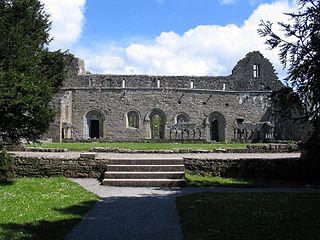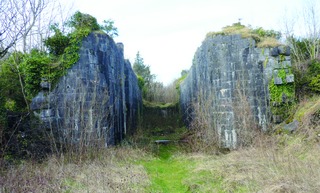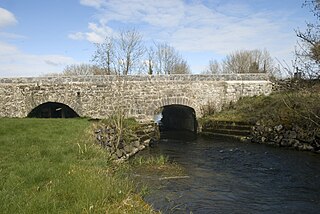
The River Shannon ) is the major river on the island of Ireland, and at 360 km in length, is the longest river in the British Isles. It drains the Shannon River Basin, which has an area of 16,900 km2 (6,525 sq mi), – approximately one fifth of the area of Ireland.

Lough Corrib is a lake in the west of Ireland. The River Corrib or Galway River connects the lake to the sea at Galway. It is the largest lake within the Republic of Ireland and the second largest on the island of Ireland. It covers 176 km² and lies mostly in County Galway with a small area of its northeast corner in County Mayo.

Arthur Edward Guinness, 1st Baron Ardilaun,, styled Sir Arthur Guinness, Bt between 1868 and 1880, was an Anglo-Irish businessman, politician and philanthropist. He is perhaps best known for giving St Stephen's Green to the Dublin Corporation for public use.

The River Corrib in the west of Ireland flows from Lough Corrib through Galway to Galway Bay. The river is among the shortest in Europe, with only a length of six kilometres from the lough to the Atlantic. It is popular with local whitewater kayakers as well as several rowing clubs and pleasure craft. The depth of this river reaches up to 94 feet.

Shown here are all the major rivers and tributaries of Ireland with their lengths. Starting with the Northern Ireland rivers, and going in a clockwise direction, the rivers are listed in regard to their entry into the different seas: the Irish Sea, the Celtic Sea and the Atlantic Ocean. Also shown are two tables. Table 1 shows the longest rivers in Ireland with their lengths, the counties they flow through, and their catchment areas. Table 2 shows the largest rivers in Ireland in cubic metres per second.

Lough Mask is a limestone lake of about 83 km2 (32 sq mi) in Counties Mayo and Galway, Ireland, north of Lough Corrib. Lough Mask is the middle of the three lakes, which empty into the Corrib River, through Galway, into Galway Bay. Lough Carra flows into Lough Mask, which discharges through the Cong Canal and underground passages in the limestone bedrock of the district. The flows from the underground passages and the Cong Canal come together at the village of Cong to form the River Cong which flows into Lough Corrib.

Killary Harbour or Killary Fjord is a fjord or fjard on the west coast of Ireland, in northern Connemara. To its north is County Mayo and the mountains of Mweelrea and Ben Gorm; to its south is County Galway and the Maumturk Mountains.

Cong is a village in County Mayo, Ireland, straddling the border with County Galway. The village is part of a civil parish of the same name.

An Fhairche, or Clonbur in English, is a Gaeltacht village in Connemara, County Galway, Ireland.

Ashford Castle is a medieval and Victorian castle that has been expanded over the centuries and turned into a five star luxury hotel. It is near Cong on the County Mayo–Galway border, on the County Galway side of Lough Corrib, in Ireland. It is a member of the Red Carnation Hotels organisation and was previously owned by the Guinness family.

The River Clare is a river in counties Mayo and Galway in Ireland.

Cong Abbey also known as the Royal Abbey of Cong, is a historic site located at Cong, County Mayo, in Ireland's province of Connacht. The ruins of the former Augustinian abbey mostly date to the 13th century and have been described as featuring some of finest examples of medieval ecclesiastical architecture in Ireland.

Loch Na Fooey, also Loch Nafooey or Lough Nafooey, is a rectangular shaped glacial lake in County Galway, Ireland. Part of the north-eastern shore lies along the border to County Mayo. The closest village is Finny, County Mayo with the County Galway village of Leenaun approximately 11 km distant.

The Cong Canal is a derelict canal in the village of Cong, County Mayo. Ireland. It was abandoned unfinished in 1854 and is popularly known as 'The Dry Canal'.

The Partraige were a people of early historic Ireland.

The Cregg River is a river in County Galway, Ireland. The river rises from a spring a half mile to the north of Cregg Mill, and flows for about seven miles into Lough Corrib. The upper stretch of the river is a nursery for fish stocking of Lough Corrib, while salmon and brown trout fishing is permitted on the lower stretches.

Ballynahinch Lake is a freshwater lake in the west of Ireland. It is located in the Connemara area of County Galway.


















